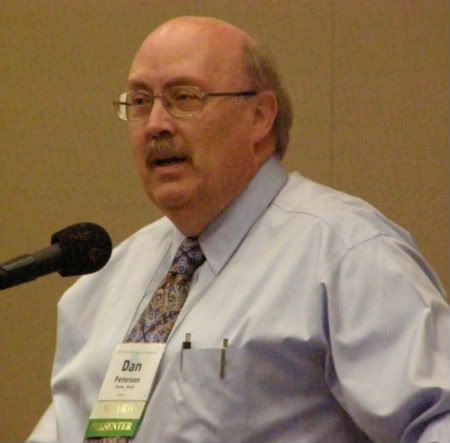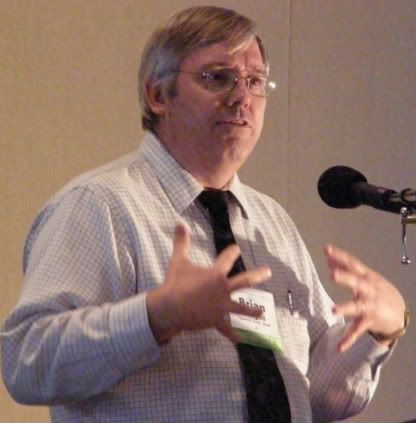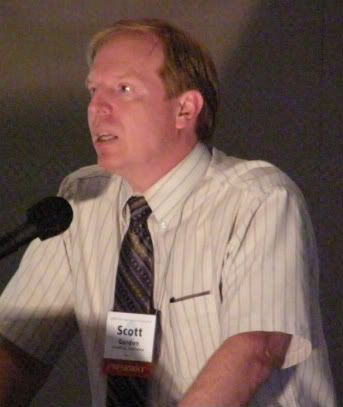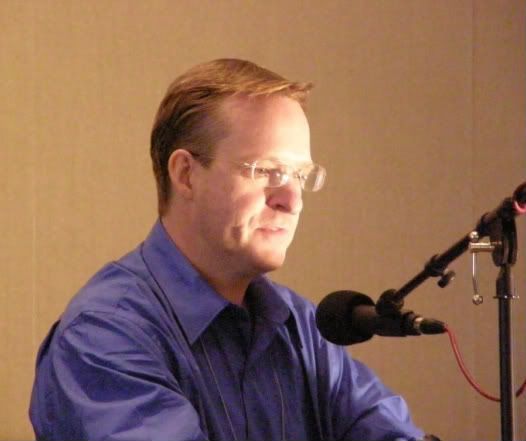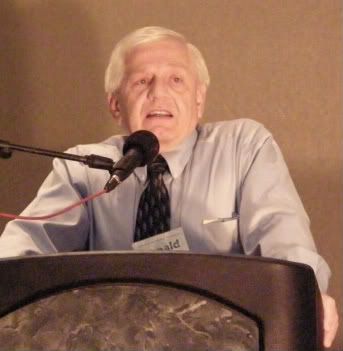"Nobody ever gets anything done the first five years."
Publication begins this fall with the first volume, then going on with 2 or 3 volumes a year from that point forward. The last word on our vita, or description, is defending. There will be planty of materials for defending and some things people will be attacking. Still, this is a great resource for better history to be written about Joseph Smith and early Mormon beginnings. The Church owns about 90% of the documents, and the leaders of the Church have insisted the publications meet the scholarly audience first, else the project will have failed. If we can lay out JS's papers he'll do fine. This is first and foremost an effort to be like other paper projects to provide the primary sources.
"The single most significant historical project of our generation." -Elder Marlin K. Jensen, Church Historian and Recorder.
We as Latter-day Saint scholars do not fully understand the documentary record of our beginnings in a way that allows us to have full understanding of what they say of our beginnings. Never before has a large group of scholars been focused together in collecting and publishing these documents in such detail.
In the 70s Pres. Hinckley was one of the liaisons for historians to the Twelve. He said the long meetings wouldn't be needed if we fully understood our history. In order to stay on track from the restoration on we must understand our history.
The Church is founded on historical events, thus it is crucial to understand the history.
What are the Joseph Smith papers?
A comprehensive collection of all documents from Joseph Smith. We are not selecting the interesting or important. We are not de-selecting to controversial or boring ones. It is not a documentary history; they are bringing together all papers associated with him and his office; letters, minutes of meetings, legal docments, written revelations, etc.
Why is the project important?
Make some of the most essential sources on the prophet's life and work available accurately as reference material for scholars and students on JS, early Mormonism, etc. It will mean better scholarship. Also, it will preserve the aging manuscripts from damage or loss.
-Provide more accurate texts
-Easier access to records
-All in one place
-Put documents in historical context
-Facilitate more and better scholarship
Other paper projects have paved the way such as the Thomas Jefferson papers, the papers of George Washington, and the papers of Benjamin Franklin papers. "I can bear testimony to the importance of these because of the Benjamin Franklin papers. During master's thesis he came across a period of time that was already completed in the Franklin papers. It was a goldmine of information. We want things that accessible.
Dr. Ralph Ketcham explained how those working on the former projects "developed methods and benchmarks of thoroughness and accuracy for
documentary publication that were so path-breaking that all previous
such publication was rendered inadequate and incomplete, and all
subsequent such publication has had to try to live up to those
standards." (see his senate testimony
here.)
Esplin and the Church want people to have confidence in the materials.
"What has been achieved thus far with the publication of the documents of US founders is all good history, accurate history, because materials have been brought together by fine scholars. Their value is unassailable and immeasurable, the footnotes are gold..." etc. paraphrased of author David McCullough
The task of documentary editors is to help readers understand the documents.
How does editing work?
1- Gathering the documents. 90% of the documents were brought across the plains, but the final 10% have been scattered everywhere.
2- Collection transcription and annotation.
3- Published volumes. (It's not a history, "it's not bedtime reading." "I have finished a tough slog," one General Authority reported after completing a volume.)
Importance for Latter-day Saints
"If it's not credible to scholars, it's not worth doing."
"If it's not accessible to Saints it's not worth doing."
Both of those being said, the initial and important audience is the scholarly community. This should improve biographical information for writers in the future. Bushman, who works on the project, had access to much of it in writing Rough Stone Rolling.
Importance for Scholars:
The General Authorities who have authorized the project have emphasized that the scholarly audience is first, that mindset must drive the project.
2,000+ documents, including those created by JS or requested by him
-Those received by Joseph or kept in his office,
-Legal matters involving JS
The volumes
Anticipate apx. 30 volumes of 500-700 pages each, which will be divided into series'.
Journals Series (including volume 1 coming out this fall, 1832-1839):
All diaries and journals, both those JS personally wrote, and those written by clerks.
-1,587 total pages
-31 pages in the hand of Joseph Smith
-250 pages dictated by him
Esplin said those written by JS are unique, always ending in a small prayer for God's blessings, etc.
Documents series
-projected a dozen volumes
-includes revelations, minutes, notes, etc.
-BoM transcript, earliest manuscripts of revelations behin Book of Commandments (D&C)
History series
-Apx. 7 volumes
-early efforts of compiling the HC under direction of JS
-Later volumes prepared by Church historians.
Legal and business series
-200+ judicial proceedings
-plaintiff, defendent, witness, etc.
-3 volumes
Administrative series
-minute and letter books of his office
How does the project work?
Document collection
-collect relevent documents
-Identify document provenance (chain of custody for each document, etc.)
-create transcriptions
Text Verification
-3 independent levels of text verification for each manuscript
-worked with James Throckmorton on looking at documents, even using photoshop
Correcting mistakes
Handwriting often difficult to read. "I will never forgive Joseph Smith for having assigned a doctor as his scribe," one papers worker said.
-"Emma had another child" the history added it didn't survive birth, but the record actually said "Emma had another chill.
Scholarly annotation takes much time, perhaps half of their effort going in that direction. There are also new maps, charts, illustrations, glossaries (including interpretation of LDS terms, even if used differently in the past by former Latter-day Saints.), works cited, and indexes.
Editing, source checking, copy editing, reviewing, internal scholarly reviews, external scholarly reviews. They are going above the norm to review everything much more closely than other projects have done. The website will keep up to date to correct and expand information, etc.
Prestigious endorsement
NHPRC endorsed
Shows the project meets rigorous standards and will be credible. Dozens are involved. Full-time employees funded by Larry H. Miller, the LDS Church, there are student researchers, part time volunteers, full time volunteers, etc.
Outside reviewers:
Harry Stout, Stephen Stein, Mary-Jo Kline, Terryl Givens
The Church Historians Press, a new imprint to publish official authoritative works. Elder Jensen believed this was a chance for a press to be established by the Church and earn prestige and reliability. Trust will be earned, they believe.
The website will include additional chronology, biographical directory, geographical directory, glossaries, newly rendered historical maps, etc.
"The closer you get to Joseph Smith in the sources, the stronger he will appear, rather than the reverse, as is so often assumed by critics." -Richard Bushman
Esplin said the closer you get to him, even through this project, you learn that he did a pretty decent job of everything, and a magnificent job in many things.
Careful, capable and sophisticated.
Regarding the legal issues, Joseph Smith seemed to understand the law and worked within the law better than his critics, one legal worker on the papers said.
Esplin concluded by acknowledging Larry Miller for the support he has given to the project. The hymn by Phelps talking about millions knowing Brother Joseph again has become something of a motto for the project.It is demanding and large, but the support, blessings, and people involved, they are confident the project will be a huge benefit.
Question and Answer
Q- Say a word about Elder Jensen and his vision for history:
It has been a pleasure, we love him. He got us aside the other day and reminded us that not just in the published volumes, but in the website the scholarship has to drive everything. This has got to be designed for the scholars. Some might say we want to connect more with the members. Jensen said the department cares about LDS, and they want to better serve them, but with this project the scholarly foundation must be laid for later and focus should not be lost on that.
Q- What has been done to limit faithful bias, or is that desirable?
I think no serious scholars expect people to step outside who they are and write "without bias," it's not really possible. To be fair-minded, to understand rather than attack and defend, is the key. They can work with scholars of every other persuasion as long as attack and defense doesn't come into play. Bushman has contrasted between an apologist who wants to attack an enemy and a historian who wants to take him to lunch. Neutral language, fairness, evidence they don't like, all included. It will be from a Latter-day Saint perspective because we are LDS, but they can tell if it is grounded in the sources and if scholarly standards are met.
Q- What is the role of the Community of Christ
It is very important, the CoC has about 5% of the papers. They have given access, permission to publish, etc. The first volume has some revelations manuscripts from the CoC. In histories the John Whitmer history which is owned by CoC was lent, improved, etc. they were happy to have it done.
Q- I am 62 will I live to see them all published?
I am 64 and I intend to live to see them all published. One of my regrets is that E Maxwell didn't live to see these published. He and Pres. Hinckley won't see it from this side of the veil.
Q- Will it impact Church curriculum?
It will have an impact and already has. The new JS manual used in RS and priesthood reflects the scholarship. HC is referenced, but an attempt was made to use the absolute best JS sources rather than questionable material. Dean Jessee etc. examined it and tried to get it as best as they could. The curiculuum writers want access to the best materials, but they don't usually do the original research in the archives, etc. Someday it will likely have an impact on a new edition of the scriptures. Just like the 1981 versions, hopefully this will make an impact on future publications.
Q- Any new surprises?
Every day there are surprises. We thought there were a few dozen legal cases and instead there are over 200!
Q- Give some current history that is in error?
So many interesting little details. One they are dealing with now that isn't sorted out deals with D&C 107, published in 1835 D&C called "on priesthood." It was put together much differently than other revelations; iot is more like sec. 20. How it originated is difficult to find. Dated March 1835, but the setting listed, makes the date incorrect. If the date works the setting is wrong. If the setting is wrong the date is wrong. There must have been an error in the minutes and will likely be redated when they figure it out. This happens fairly often.
Q- Will it be database searchable, cross-referenced, indexed?
Yes, yes, and yes. "A documentary book is only as good as its index." There are 3 full-time people working on indexing volume one. Each vol. will have index.
Q- On the web?
One day it will be available free of charge online, but that is being sorted out. Clearly the church has an interest in making this available.
Q- What about the roles of the scribes?
New scribes have been discovered, there will be information about them. Revelations 1 published in first quarter of 2009 has a scribal directory. Each major scribe has an entry saying who he was and detailing the methods of each. The scribes are a positive and negative. Some left or died young, etc. Willard Richards began in 1841 a continuous record carrying through to the end was great.
Q- Are there previously unknown papers?
Yes, private collections, documents from the archives, etc. that were new.
Q- What are qualifications for the "best" when you have multiple papers?
There are 117 docs in the first volume, most of which are revelations. Many of them exist in more than one. They started out thinking they would take the last known version, but that didn't work well, so they choose the earliest complete manuscript of a revelation that they can verify and that is what they use. Sometimes there is a toss-up, these are acknowledged, all are listed in the document calendar.
Q- Will they include KEP or BoA?
Yes. In some fashion. It is yet to be sorted out fully. These should be in the documents three colume, with the help of Gee and Hauglid on the dating of the documents. In the rev. and translation series they hope to have a section on the BoA and Egyptian materials as well.
For more on the project, see the JSP website.
 from each presenter. Transcripts are forthcoming from FAIR. Several have been posted there; links added below.
from each presenter. Transcripts are forthcoming from FAIR. Several have been posted there; links added below.


 5
Comments
5
Comments